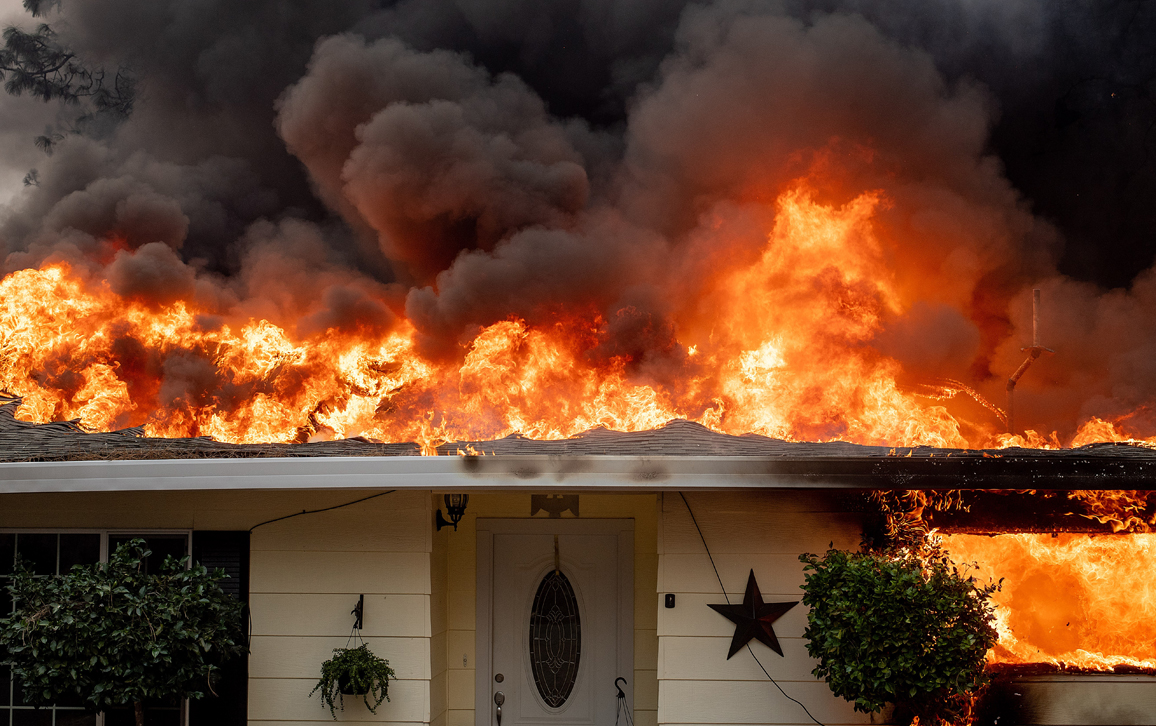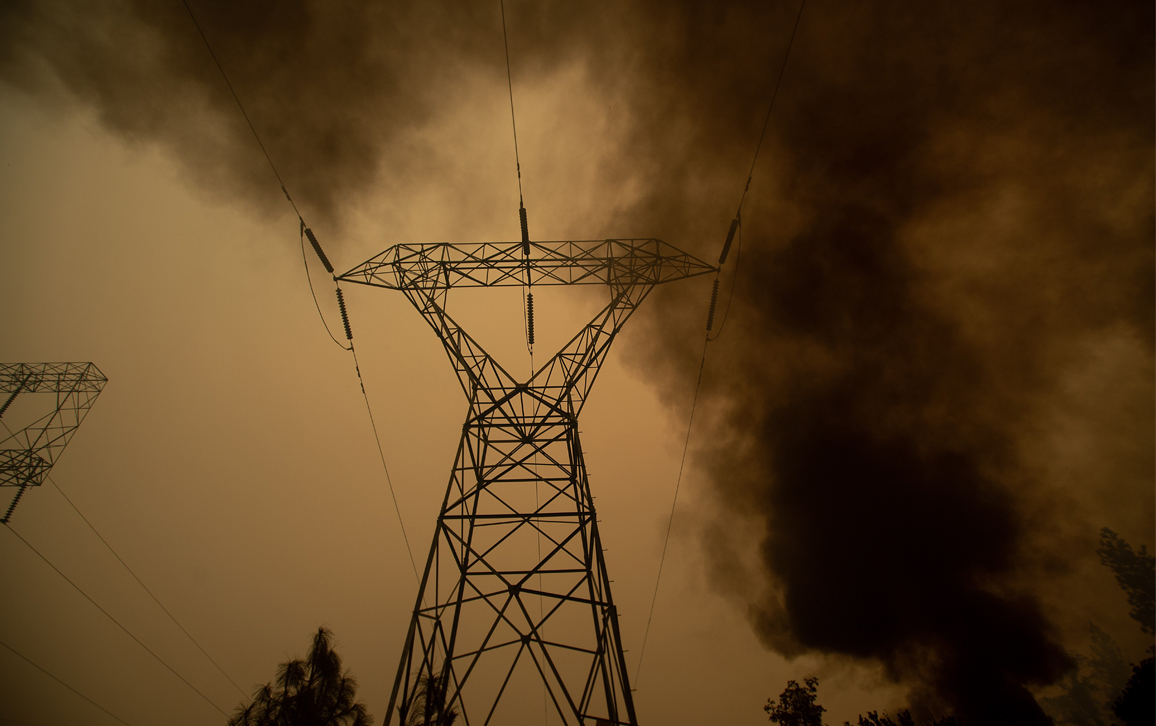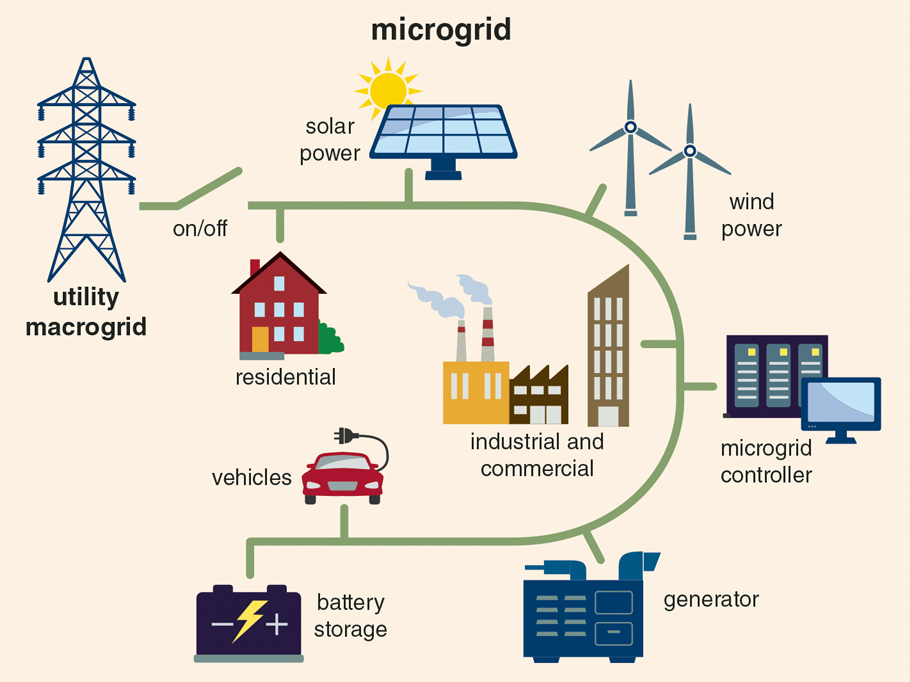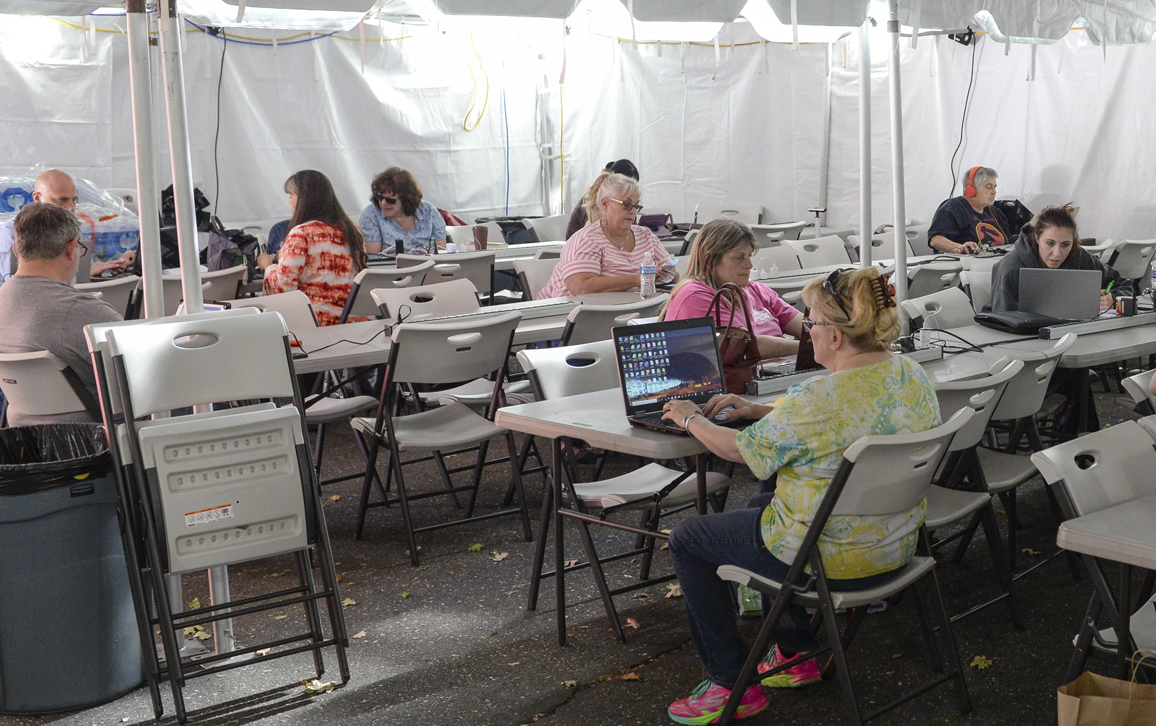Pulling the Plug on Climate Change Wildfires
By Robert Chianese
There is no easy eco-fix for the power grid.
There is no easy eco-fix for the power grid.

Ominous weather—hot or cold yet dry and windy—makes me and many Californians check the skies for flames and smoke. Ridgetop and downslope winds gust from about 80 to 130 kilometers per hour. Called Diablos in the north of the state and Santa Anas in the south, these winds once fueled flames from October to April. They blow almost year-round now, fanning conflagrations such as the Thomas Fire that nearly brought down my own home in December 2017.
Wildfires are becoming more prevalent in many parts of the country, burning this August in 14 states, including Alaska, Arizona, Oregon, and Texas. Fire season is growing more perilous in other regions of the globe as well, from Australia to Europe. Stephen Pyne, emeritus professor at Arizona State University and author of more than 20 books on the history and culture of fire, calls our global era one of fire, or the Pyrocene.

Noah Berger
Human-caused global warming creates weather conditions that fuel these flames: prolonged drought, fierce turbulent winds from lingering high pressure, and dried-up vegetation. California’s arid landscape is naturally prone to burn, but climate change is making the threat worse, primarily by generating high, lingering heat events that dry out vegetation even more (see “Coexisting with Wildfire”). Alejandra Borunda reported in National Geographic in October 2019 that 15 of the 20 largest California fires have occurred since 2000, and the area burned by wildfires annually has increased fivefold since the 1970s.
The wildfire situation in California is now dire. More than 16 fires burn at any one time, with nearly 1.5 million hectares burned since January and millions of residents forced to evacuate. California has a rainfall deficit in 2020 and new fires are raging. The Golden State has become the Wildfire State.
The massive and aging macrogrid further exacerbates the problem. The macrogrid is the assembled system of power generators—from oil, gas, solar, and wind sources—with transmission and distribution lines, switching stations, and community and local connections from which we draw electrical power. This macrogrid constitutes what Sonia Aggarwal of the energy and environmental policy firm Energy Innovation calls “the world’s largest machine,” with power lines that could wrap around the Earth eight times.
Wind or tree falls can cause these often-aging power lines to spark or crash in flames, igniting vegetation left drier by climate change. Taryn Luna reported in the Los Angeles Times in 2019 that equipment from California’s three largest utilities companies—Pacific Gas and Electric (PG&E), Southern California Edison (SCE), and San Diego Gas & Electric (SDG&E)—sparked more than 2,000 fires from June 2014 through 2017.
Millions have sued PG&E for losses in the November 2018 Camp Fire in Northern California that obliterated the city of Paradise, killed 86 people, and destroyed 14,000 homes and 5,000 other buildings. PG&E has accepted liability, declared bankruptcy, and agreed to a $13.5 billion fine.
An SCE power line started the Woolsey Fire in November 2018, burning 1,600 homes as it raced toward the ocean through Malibu in the south and killing three people. A tree branch on an SCE power line started the Easy Fire in October 2019 that burned in the Simi Valley near Los Angeles. SCE has agreed to a $350 million fine.
In hopes of preventing fires while keeping the lights on, power companies are developing a different sort of electric-delivery model: the microgrid. A microgrid is a local energy grid that can disconnect from the macrogrid when needed, autonomously powering a community for at least a short time. This smaller power system can use oil and gas but may also use locally generated renewable energy sources such as solar panels. It has fewer and shorter transmission lines and can curtail carbon production. Although microgrids offer the potential to both reduce greenhouse gas emissions and shorten lines that spark fires, the technology required to support their widespread implementation is not fully developed. Energy companies are still left grasping for near-term solutions as they work toward the long-term promise of the microgrid.
California utilities companies have a number of tools in their fire-prevention toolkit, though none are a perfect fix. Tree and brush clearance—sometimes hundreds of meters wide and thousands of kilometers long—can help, but it cannot fend off flying embers once fires blow up. Clearing these massive swaths in a forest also takes a damaging toll on the environment.
Burying overhead lines would eliminate sparks, but at a staggering financial cost. PG&E claims that building new overhead distribution lines costs $800,000 per 1.6 kilometers, whereas burying existing overhead lines costs $3 million per 1.6 kilometers. PG&E has more than 172,000 kilometers of distribution lines, of which more than 130,000 kilometers are overhead.
With power lines exposed, power companies have settled on the unpopular solution of shutting down power altogether when fire risk is high. These preventive shutoffs, known as public safety power shutoffs, can affect thousands of customers over huge areas of the state, forcing schools and businesses to close in fire seasons.
The Golden State has become the Wildfire State.
Robocalls warning of an impending fire-prevention shutoff can spark fear, anger, and confusion. Power often stays on after repeated phone alerts, causing residents to question whether the fire danger is real. For those who are evacuating, getting out of homes in the middle of the night without lights or traffic signals is dangerous. People dependent on medical equipment are especially vulnerable.
In some cases, fire blows through towns before power is shut off. The Thomas Fire in Ventura County raged from town to town over the hills surrounding my own home, driven by winds so strong that the flames were flat as they spread for kilometers. Neighborhood power remained on, and we did not get an alert from the power company. My neighbors, racing down the hill before midnight, yelled to us to get out, and we did. Unable to sleep, my son and I went out by car at 3 AM to watch the fires burn whole streets and houses in haphazard fashion.
I snuck under the yellow tape the next morning and saw our house still standing. I later found that the fire hydrants didn’t work because their power went out. A good Samaritan crossed the lines late at night and used garden hoses to put out spot fires in yards, including our own.
To minimize the confusion and inconvenience of public safety power shutoffs, California utilities companies are now employing sectionalizing devices that separate the power grid into smaller segments so they can direct the shutoffs to more narrow regions. This technology creates, in effect, a smaller, less-fire-prone grid for the remaining customers still receiving power. Although fewer customers would be affected at any one time, customers would still intermittently find themselves without power during fire season.
A more long-term solution under development, the microgrid, offers targeted shutoffs from the centralized power source without blackouts. Should high fire risk warrant shutting down power lines to the main grid, microgrids could continue to independently power a community or installation for limited periods using local generators or—ideally—local renewable resources such as solar panels or wind turbines, backed up by storage batteries.

Noah Berger
Hundreds of microgrid projects are underway worldwide that utilize both solar and fossil-fuel energy sources, from the Ta’u Solar City in American Samoa to the Kisii County Microgrids in Kenya. Universities, which need steady power in laboratories to prevent loss of valuable experiments, have been among the earliest adopters of microgrids. At the University of Texas at Austin, a microgrid has supplied almost 100 percent of the campus’s power since 1974. The microgrid at the University of California, San Diego, supplies about 92 percent of the university’s electricity. Saddleback College’s microgrid in Mission Viejo, California, has provided both heat and power for the past six years, operating independently of the macrogrid when necessary in what is called “island mode,” with the support of diesel power generators.
In 2013, SDG&E installed a microgrid for the desert community of Borrego Springs, California, as a model of what such installations can do. Solar energy with backup diesel generation currently powers this microgrid, but with the help of a recently awarded grant from the United States Department of Energy’s Solar Energy Technologies Office, SDG&E is working to upgrade the microgrid so that it can rely solely on renewable energy.
In 2018, Kaiser Permanente installed the first renewable-energy-fueled microgrid at a California hospital at its Richmond Medical Center. In the event of a power outage, energy generated by solar panels and stored in batteries, in addition to the power supplied by traditional backup generators, can continue to supply power to critical hospital equipment.
California’s energy regulators are pushing power companies to have more microgrids in place before the onset of the next fire season, presumably in areas most likely to experience public safety power shutoffs. PG&E is working to install several temporary microgrids that will run on diesel fuel when disconnected from the macrogrid, at least until cleaner energy options are available. In Calistoga, California, for example, the company has already installed a microgrid powered by a diesel generator that can supply power to 800 customers when power lines to the main grid are shut off. PG&E is also working toward installing microgrids powered by locally generated green energy, although these projects will take more time.
In theory, microgrids present a single solution to multiple problems. They allow for more-targeted shutdowns from the macrogrid while also enabling the cutoff community to continue to produce its own energy.
Microgrids powered by locally generated green energy could also help right a major contradiction in California’s green energy consumption. The California Energy Commission estimates that 34 percent of California’s electricity came from renewable sources in 2018. But delivering these green energy sources still requires stringing high-tension wires over vast distances—a key point that is rarely acknowledged. We boast that these energy sources are green, but the delivery systems are not. The microgrid could one day help alleviate the need for these long, fire-prone delivery lines.
But despite its promise, microgrids are still hampered by limitations that will likely prevent their widespread use in the near term. Microgrids that rely on locally generated green energy must also rely on batteries to store that energy. Battery-storage technology is advancing but can only keep a community running for a limited period. Emily Pontecorvo reports in August 2020 in Grist that the world’s largest battery installation, developed for the Gateway Energy Storage project in San Diego, boasts of being able to store and deliver 230 megawatts of renewable power to the California grid—but for just one hour. The grid would need as much as 15,000 megawatts of storage to reach the state’s goal of running solely on fossil-fuel-free energy by 2045.

Barbara Aulicino
SCE admits that the stand-alone battery technology for long-term power supply probably needs more time to evolve. The company states that, “an advanced fully renewable microgrid will likely require lead time beyond 2020.”
With limited battery storage, green-energy-powered microgrids typically bring with them the unfortunate need to keep the vast macrogrid up and running, on call for electricity when local renewable sources can’t meet the demand. Today’s microgrids also often rely on backup generators that burn the fossil fuels that trigger the climate change that makes the fires more likely in the first place.
With any electrical system we use, there are going to be problems. We as a society have set ourselves up for this challenge by burning the fossil fuels that turned California into a tinderbox in the first place (see “Climate-Disturbed Landscape”).
“We boast that these energy sources are green, but the delivery systems are not.”
California Governor Gavin Newsom, in the middle of a recent spate of fires, excoriated PG&E and other power utilities as greedy outfits, unwilling to spend funds to upgrade equipment and keep areas under power lines clear of brush and trees. He even downplayed climate change as the sole cause: “It’s more than just climate change. It’s about the failure of capitalism to address climate change,” Newsom said. “It’s about decades of mismanagement. It’s a story about greed.”
These understandable and angry accusations sit well with most citizens, who are looking to blame something or someone for their lingering distress and heavy losses. What will it take for this ecologically savvy governor in a progressive state that has been repeatedly afflicted by harsh climate change effects to call out the citizenry itself as a contributing source of wildfires? This conflict evokes the tip of the iceberg (now melting) for what political, business, and community leaders will have to confront when devising acceptable strategies for public action.

Matt Bates/Chico Enterprise-Record/AP Images
The California wildfire problem brings together the nexus of politics, technology, economics, and public anger when it comes to the repayment costs of disasters. We must work together to push for solutions that include both greener energy and greener energy delivery. Assessing power companies and tallying the “tech debt” required to modernize all our global systems and infrastructures will take extensive cooperation between public and private entities, much like the global ramping up to fight a new global world war.
The Union of Concerned Scientists sums up the challenges facing the world as it works to combat global warming: “Scale, speed, and cost are the main barriers to all these technologies and approaches. In the United States, strong state- and federal-level policies—and large-scale investment in research and development— are crucial.”
As new wildfires rage in the West under a shroud of life-threatening heat, the need for these technological advances is ever more pressing. We must have safer power-distribution systems with actual working stand-alone microgrids, as well as public cooperation in reducing fossil-fuel consumption, if we are ever going to put out the flames that set California ablaze.
Click "American Scientist" to access home page
American Scientist Comments and Discussion
To discuss our articles or comment on them, please share them and tag American Scientist on social media platforms. Here are links to our profiles on Twitter, Facebook, and LinkedIn.
If we re-share your post, we will moderate comments/discussion following our comments policy.